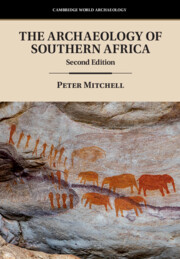Book contents
- Frontmatter
- Contents
- List of Figures
- List of Tables
- Acknowledgments
- 1 Introduction
- 2 Frameworks
- 3 Contexts
- 4 Origins
- 5 A Cognitive Revolution
- 6 Hunter-Gatherers of the Late Pleistocene
- 7 Archaeologies of the Pleistocene/Holocene Transition
- 8 Hunting, Gathering, Intensifying: Forager Histories in the Holocene before 2000bp
- 9 Taking Stock: Herders and Hunter-Gatherers
- 10 Farmers and Foragers: the First Millennium
- 11 Forming States: the Zimbabwe Culture and its Neighbours
- 12 Recent Farmers and Hunter-Gatherers in Southernmost Africa
- 13 Colonisation, Conquest, Resistance
- 14 Perspectives and Prospects
- Glossary
- References
- Index
13 - Colonisation, Conquest, Resistance
Published online by Cambridge University Press: 15 May 2024
- Frontmatter
- Contents
- List of Figures
- List of Tables
- Acknowledgments
- 1 Introduction
- 2 Frameworks
- 3 Contexts
- 4 Origins
- 5 A Cognitive Revolution
- 6 Hunter-Gatherers of the Late Pleistocene
- 7 Archaeologies of the Pleistocene/Holocene Transition
- 8 Hunting, Gathering, Intensifying: Forager Histories in the Holocene before 2000bp
- 9 Taking Stock: Herders and Hunter-Gatherers
- 10 Farmers and Foragers: the First Millennium
- 11 Forming States: the Zimbabwe Culture and its Neighbours
- 12 Recent Farmers and Hunter-Gatherers in Southernmost Africa
- 13 Colonisation, Conquest, Resistance
- 14 Perspectives and Prospects
- Glossary
- References
- Index
Summary
Neither southern Africa’s archaeology nor its history or contemporary social and political structure can be understood without reference to its experience of colonialism and conquest or of the resistance to this. This chapter therefore looks at the archaeology of Portuguese exploration and subsequent settlement in Mozambique, as well as at the much more expansive colonisation of southern Africa set in motion by the establishment of a Dutch East India Company (VOC) base at Cape Town in 1652. It traces the spread of European settlement into the region’s interior, the emergence of new creolised populations on and beyond the frontiers of that settlement, the institutionalisation of the social, economic, and political structures that led to apartheid, and – crucially – the resistance of Indigenous societies to this. Chapter 13 also discusses the Mfecane and the emergence of the Zulu, Basotho, Ndebele, and Swazi states, among others, to emphasise their contemporaneity and potential connections with European settler expansion and to encourage comparative study of processes of state formation, migration, and population incorporation common to both.
Keywords
- Type
- Chapter
- Information
- The Archaeology of Southern Africa , pp. 393 - 431Publisher: Cambridge University PressPrint publication year: 2024

